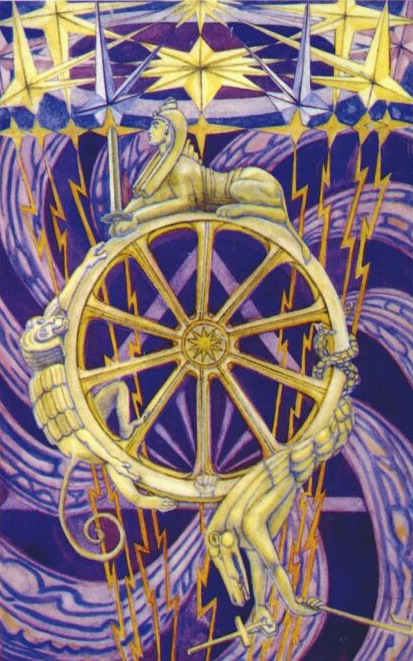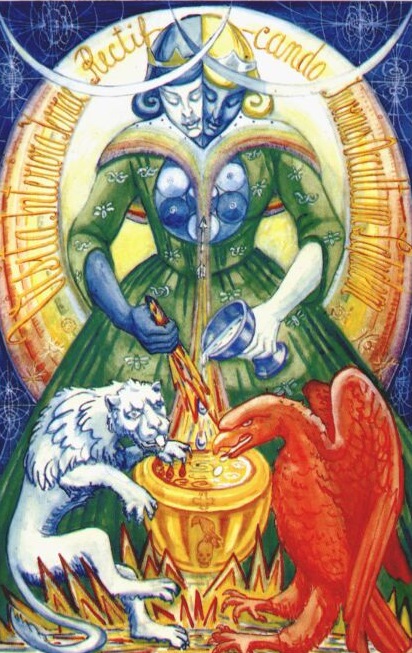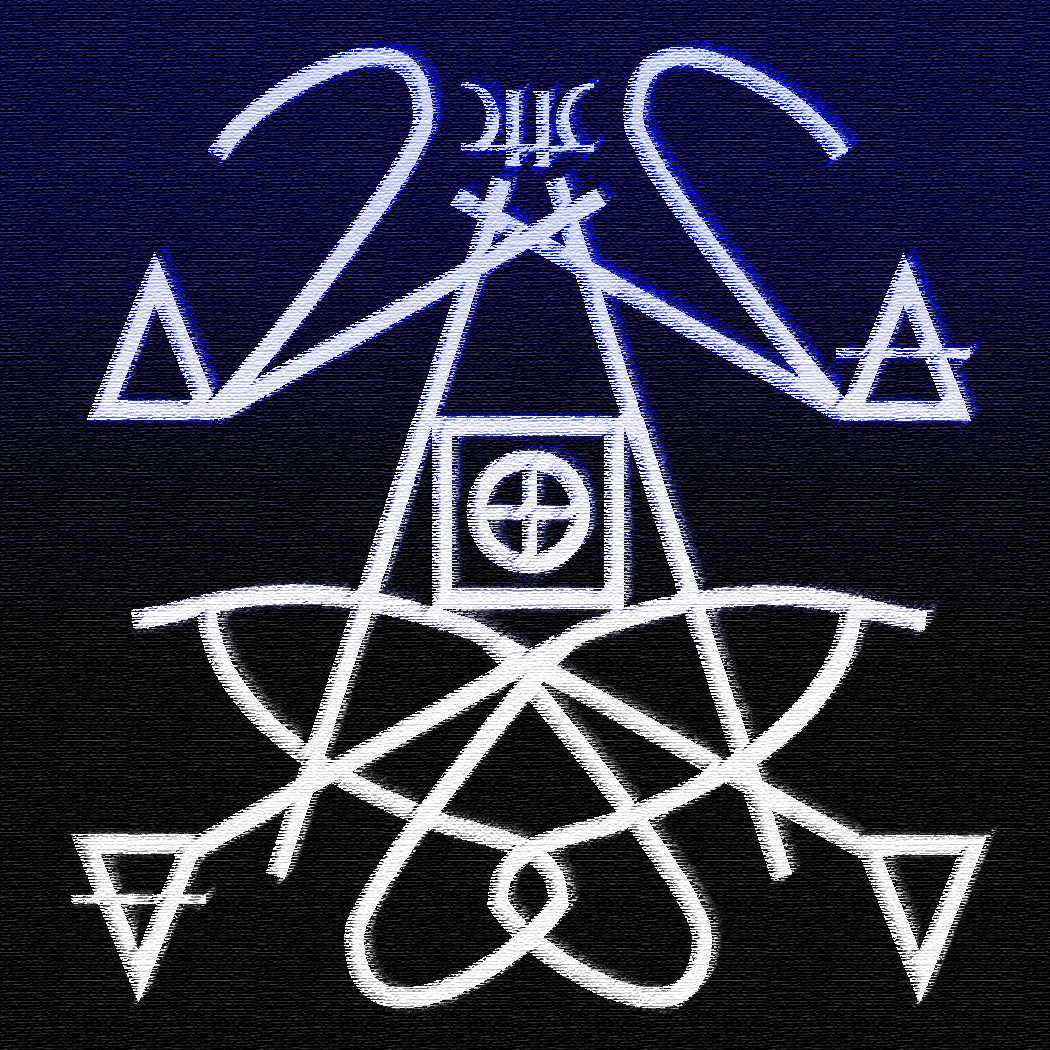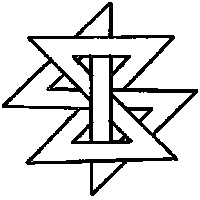|
GoN Enumes: Business = 4 / Slavery = -4 Mantra: TER CHU MIG NOF
Archetypal Dichotomy: Duty-Quest-Task / Pact-Oath-Vow
The Numeric Egregore of Four corresponds to the planet Jupiter, which rules over the 9th House in astrology (Sagittarius), dealing with our academic explorations and expanded horizons.
Jupiter, the planet of expansion and growth, profoundly influences the Numeric Egregore of Four. This influence is a guiding force, bringing experiential wisdom and well-researched knowledge to the thoughtform.
This philosophical influence makes Four-identifying people advisors in their fields and may lead them to careers in law, publishing, academia, religion, counseling and other areas where good judgement and higher education are valued. They may find themselves as judges, lawyers, editors, scholars, financiers, publishers, ministers, or clergymembers.
The distinguishing characteristics of the Numeric Egregore of Four are affluence, adaptation, and elevation. Positive traits include optimism, prosperity, generosity, and kindness. Negative traits include misfortune, pessimism, propaganda, and sudden unexpected changes.
- Planet: Jupiter
- Basic Meaning: Expansion
- Basic Symbol: Equal-Armed Cross
- Chaostar Aura: Wealth, Desire, Affluence, Higher Academia, Philosophy (Blue)
- Physiogeography: Thymus gland, Circulatory system, Heart; Right Arm and Hand
- Psychoscape: Consciousness, Circuit; Sense of Touch
- Example Godforms: Zeus, Midas, Sri Lakshmi, Ganesha, Yog-Sothoth, and Croesus
- Esotericon: (4) Power: Wordly power of command and/or wealth
- Basic Faculties: Expansion in all its forms, rules abundance, affluence, fortune, luck, prosperity, riches, wealth. Also rules long distance communication, long distance travel, legal matters, taxation, investments, higher education and academic matters, the deeper mind and all those who are in a position to help by providing opportunities.
Magickal uses and other faculties
The Numeric Egregore of Four's subordinate eidolons teach us magick
Four introduces us to Ritual Magic such as the rituals of the elements (what Traditional Witchcraft has deemed the Calling of the Corners or Watchtowers) and the feasts of the times, the greater and lesser invoking and banishing pentagram and hexagram rituals. The Gnostic Mass, Liber Resh vel Helios, the Star Ruby and Star Sapphire, the Abramelin Procedure, the Knowledge and Conversation of the Invoked Augoeides, the Gnostic Pentagram Ritual, the Gnostic Chaosphere Ritual, and the greater and lesser observances of Chaos Monasticism.
Additionally, we've contributed Z(enseider)'s Atraxic Mass, Z(enseider)'s Alchemical Yggdrasil Katalepsis meditation, and Z(enseider)'s Unicursal Octogram Ritual, which may be adapted to invoking or banishing. This circuit is very plugged into esoteric correspondences and their place in ceremonial magic.
Oracular keys of the Ergi Seidr heuristic
The occultural neophilia of an archetypal arcanum, recast in the schizodivergent lexical arrangement of Speculative Ma'athematics, navigates the GoN through profane dialectics.
The planetary atu is the primary correspondence that's referenced directly
- ZZ Planet Atu: 10. The Grind
- ZZ Planet Atu Alt: The Game or the Furies & Fates or Reputation Economics
- ZZ Planet GoN Enume: K = 3
- ZZ Planet: Jupiter
- ZZ Planet Archetypal Dichotomy: Duty-Quest-Task / Pact-Oath-Vow
- ZZ Planet Jungian: The Explorer / The Hero
- ZZ Planet Greek deity: The Moirai
- ZZ Planet keywords: Fortune; destiny; new beginnings; opportunities; to revolve; cycles; impermanence; renewal; eternal return; solution; change; financial gain. An emotional conundrum to resolve; blockage; impasse; need for outside help; halt; wheel of karma --- successive reincarnations.
Religioccultural minutia referencing Four (4)
- In the Western Esoteric Tradition, the four basic elements are fire, air, water, and earth; their authorship is generally credited to Empedocles, a 5th century BCE Greek from Sicily. The elements are cross-referenced by combinations of the four alchemical conditions: dry, hot, cold, and wet, which each correspond to a form of bodily fluid called "bile," they range from feces and urine to blood and phlegm.
- The elements, conditions, and biles are arranged as:
- Air: hot & wet - blood (red bile)
- Fire: hot & dry - urine (yellow bile)
- Water: cold & wet - phlegm (blue bile)
- Earth: cold & dry - feces (black bile)
Buddhism
There are so many regional languages of Buddhism that the few theological sects hardly differ as compared to the geographic and lingual differences. Buddhism exists in:
- Sanskrit-speaking India
- Pali-speaking India
- Pāli, also known as Pali-Magadhi, is a classical Middle Indo-Aryan language on the Indian subcontinent. It is widely studied because it is the language of the Buddhist Pāli Canon or Tipiṭaka as well as the sacred language of Theravāda Buddhism. Pali is designated as a classical language by the Government of India.
- Bengali-speaking Bangladesh and India
- Burmese-speaking Myanmar, Bangladesh, and India
- The many dialectics of Chinese-speaking Han China
- Indosesian-speaking Indonesia
- Japanese-speaking Japan
- Khmer-speaking Cambodia, Thailand, and Vietnam
- Korean-speaking North and South Korea
- Mongolian-speaking Mongolia, Russia, China, and Kyrgyzstan
- Sinhalese-speaking Sri Lanka
- Lhasa Tibetan-speakers in the captial city of the Autonomous Tibetan Region
- Tagalog-speakers in the Phillipines
- Thai-speaking Thailand and the Thai-Chinese enclaves in the country
- Vietnamese-speaking Vietnam
- In Buddhism, the four noble truths (or "the four arya satya") are "the truths of the noble one (the Buddha)," demonstrations of how things really are when they are seen accurately and without illusory pretense or cognitive bias.
- The four noble truths are:
- Dukkha (not being at ease, 'suffering', from dush-stha, standing unstable): Dukkha is an innate characteristic of transient existence; nothing is forever, this is painful.
- Samudaya (origin, arising, combination; 'cause'): together with this transient world and its pain, there is also thirst, craving for, and attachment to this unsatisfactory existence.
- Nirodha (cessation, ending, confinement): the attachment to this transient world and its pain can be severed or contained by the confinement or letting go of this craving.
- Marga (road, path, way): the Noble Eightfold Path is the path leading to the confinement of this desire and attachment and the release from dukkha.
- In early Buddhist texts, mindfulness is established in four main ways, known as the domains of mindfulness (awareness or contemplation):
- mindfulness of the body
- (Pāli: kāyagatā-sati; Skt. kāya-smṛti)
- mindfulness of feelings
- (Pāli vedanā-sati; Skt. vedanā-smṛti)
- mindfulness of the mind
- (Pāli citta-sati; Skt. citta-smṛti)
- mindfulness of principles or phenomena
- (Pāli dhammā-sati; Skt. dharma-smṛti).
- In Buddhism, the four divine abidings are:
- loving-kindness
- compassion
- sympathetic joy
- equanimity
- In Buddhism, the four stages of enlightenment are:
- the stream-enterer
- the once-returner
- the non-returner
- the arahant
- In Buddhism, the four main sacred pilgrimage sites are:
- Lumbini
- Bodh Gaya
- Sarnath
- Kusinara
Hinduism
- In ancient India, the Vedas (lit. 'knowledge') are a large body of religious texts composed in Vedic Sanskrit. The texts constitute the oldest layer of Sanskrit literature and the oldest scriptures of Hinduism. There are four Vedas, which were all written during the Vedic period (Iron Age India). The oldest of these, the Rigveda, was written circa 1500–1200 BCE, while the other three Vedas (Yajurveda, Samaveda, and Atharvaveda) were written circa 1200–900 BCE.
The four Vedas: the Rigveda, the Yajurveda, the Samaveda, and the Atharvaveda each have four subdivisions – the Samhitas (mantras, and benedictions), the Brahmanas (commentaries on and explanations of rituals, ceremonies and sacrifices aka Yajñas), the Aranyakas (text on rituals, ceremonies, sacrifices, and symbolic-sacrifices), and the Upanishads (texts discussing meditation, philosophy, and spiritual knowledge). Some scholars add a fifth category – the Upāsanās (worship).
Vedas are śruti ("what is heard"), distinguishing them from other religious texts, which are called smr̥ti ("what is remembered"). Hindus consider the Vedas to be apauruṣeya, which means "not of a man, superhuman" and "impersonal, authorless," revelations of sacred sounds and texts heard by ancient sages after intense meditation.
Over 20,000 mantras are in the four Vedas combined. In some contexts, Veda refers only to the Samhitas, the collection of mantras, which encompass the oldest layer of Vedic texts.
The Vedas have been orally transmitted since the 2nd millennium BCE with elaborate mnemonic techniques. The mantras, the oldest part of the Vedas, are recited in the modern age for their phonology rather than semantics. They are considered "primordial rhythms of creation," preceding the forms they refer to. By reciting them, the cosmos is regenerated "by enlivening and nourishing the forms of creation at their base."
- In Hinduism, a key concept is Purusartha, which literally means "object(ive) of mortals." Purusartha refers to the four ascending goals or aims of human lives. The four Purusartha objectives of mortal life are:
- Dharma (righteousness, moral values)
- Artha (prosperity, economic values)
- Kama (pleasure, love, psychological values)
- Moksha (liberation, self-realization, spiritual values)
- In Hinduism, the four phases of existence are
- Brahmacharya (student life)
- Grihastha (household life)
- Vanaprastha (retired life)
- Sannyasa (renunciation)
- the four primary castes or strata of society are
- Brahmana (priest/teacher)
- Kshatriya (warrior/politician)
- Vaishya (landowner/entrepreneur)
- Shudra (servant/manual laborer)
Abrahamic faiths
- In the New Testament, The four Gospels of Jesus (the same story) are told by Matthew, Mark, Luke, and John.
- In the New Testament, the four horsemen of the Apocalypse are figures in the Book of Revelation, a piece of apocalyptic literature attributed to John of Patmos, and generally regarded as dating to about AD 95. Similar allusions are contained in the Old Testament books of Ezekiel and Zechariah, written about six centuries prior to the Book of Revelation. Though the text only provides a name for the fourth horseman, later commentary identifies them as embodiments of Conquest (Zelos), War (Martius), Famine (Limos), and Death (Thánatos or Móros).
- Revelation 6 tells of a book or scroll in God's right hand that is sealed with seven seals. The Lamb of God/Lion of Judah opens the first four of the seven seals, which summons four beings that ride out on white, red, black, and pale horses. All of the horsemen, save for Death, appear as human.
In John's revelation the first horseman rides a white horse, carries a bow, and is given a crown as a figure of conquest, perhaps invoking pestilence, or the Antichrist. The second carries a sword and rides a red horse as the creator of (civil) war, conflict, and strife. The third, a food merchant, rides a black horse symbolizing famine and carries the scales.
The fourth horsemen rode a pale horse. "Its rider was named Death, and Hades was following close behind him. They were given power over a fourth of the earth to kill by sword, famine and plague, and by the wild beasts of the earth." (Revelation 6:8 NIV)
- In Judiac symbology, the Tetragrammaton is the four-letter epithet for the personal name of God (e.g., YHVH or "yud-hey-vav-hey," which some people pronounce as Yahweh and others, mostly Christians, as Jehovah). Its elocution is lost to due to the Jewish religious taboo never to speak God's name aloud.
- Instead, the Jews used pseudonyms like Adonai (Lord), Elohim (God), and HaShem (the name), or sometimes Shem Hamforash (the special name).
Tetragrammaton forms the root meaning "to be," and some have implied it means "He-Who-Is," or "He who brings being into being."
The origin of the taboo on pronouncing God's name aloud — viewing this as irreverent or possibly even a violation of the commandment not to take God's name in vain — is not entirely clear. However, some attribute it to a Temple practice in which only the High Priest was allowed to utter the name, and only when in the Temple and reciting the priestly blessing. Some Jews and non-Jews have suggested that the name itself has magical power, an idea that Maimonides dismissed but that is embraced in some Kabbalistic texts.
- The four Matriarchs of Judaism are Sarah, Rebekah, Leah, and Rachel.
- The four Kabbalistic worlds are Atziluth (archetypal), Briah (creative), Yetzirah (formative), and Assiah (material)
- The four archangels in Islam are Jibraeel (Gabriel), Mikaeel (Michael), Izraeel (Azrael), and Israfil (Raphael).
- There are four books in Islam are the Torah, Zaboor, Injeel, and Quran.
We'd like to take this opportunity to expose fraud and cultural theft.
We intended to dislpay and describe the faux-Ojibwe Medicine Wheel, but when we read what transpired to give birth to this New Age symbol we quickly changed our minds.
Instead, we wish to relay an abbreviated version of its history for those unaware.
The modern Medicine Wheel symbol was invented as a teaching tool in about 1972 by Charles Storm, aka Arthur C. Storm, writing under the name Hyemeyohsts Storm, in his book Seven Arrows and further expanded upon in his book Lightningbolt. Various people have since used it to symbolize a variety of concepts, some based on Native American religions, others newly invented, and of more New Age orientation. It is also a common symbol in some pan-Indian and twelve-step recovery groups
Vincent LaDuke (a New Age spiritual leader going by the name Sun Bear), who was of Ojibwe descent, started also using the Medicine Wheel symbol, combining the basic concept with pieces of disparate spiritual practices from various Indigenous cultures, and adding elements of new age and occult spiritualism. LaDuke self-published a newsletter and several books and formed a group of followers named the Bear Tribe, of which he appointed himself the medicine chief. For a fee, his mostly wealthy and white followers attended his workshops and retreats, joined his "tribe", and could buy titles and honors traditionally reserved for respected elders and knowledge keepers. For these activities, LaDuke was denounced and picketed by the American Indian Movement.
Storm and LaDuke have been described as "plastic medicine men". They and others who have used the medicine wheel symbol to introduce their own ideas and concepts from other cultures into what they claim are Native American and First Nations teachings have been accused by traditional Natives and activists of harming and displacing traditional teachings for financial motives.
New Age writers tend to center the idea of the medicine wheel as an individualistic personal development tool and use a stylized version with the circle divided into colored quadrants, with various personal qualities assigned to the colors and quadrants. This redefinition starkly contrasts the Indigenous view of ceremony and sacred sites being rooted in the community rather than the individual.
Though some concepts are founded in traditional Indigenous teachings, many are not and are confused due to misinformation.
The Chinese, Vietnamese, Korean and Japanese are superstitious about the number four because it is a homonym for "death" in their respective languages.
[We need a fact check on that, Thom.]
- Element: Water
- Condition: Wet & Cold
- Fluid: Phlegm (Blue bile)
- Alchemical Agent: ?
- Zodiac: Sagittarius (December)
- Zodiac GoM: (Impulse) Action [Incineration] ML2/T
- Season: Yule (Winter Solstice) December 19-23
- Metal: Tin
- Stone: Turquoise, Labradorite, Beryl
- Aroma: Sandalwood
- Great Old One: Yog-Sothoth
- Pesedjets: Nut (nightsky)
- Ouranian: CHOXAH
- #ppl: 005
- Tetractys: Tetrad
- Proportion: Dimension
- Tautology:
- Ratio: 4:3
- Interval: Perfect Fourth
- Note: D
- Geometry: Square
- Euclidean isometries: Translation
- Platonic Solid: Tetrahedron
Oracular keys of the Ergi Seidr heuristic
The occultural neophilia of an archetypal arcanum, recast in the schizodivergent lexical arrangement of Speculative Ma'athematics, navigates the GoN through profane dialectics.
The zodiacal atu is an auxillary correspondence that's referenced parenthetically
- ZZ Zodiac Atu: 14. Woke
- ZZ Zodiac Atu Alt: Psyberandrogynous Luminary
- ZZ Zodiac GoN Enume: O = -1
- ZZ Zodiac: Sagittarius
- ZZ Zodiac Archetypal Dichotomy: Adversity/Dissolution
- ZZ Zodiac Greek deity: Iris
- ZZ Zodiac keywords: Combination of forces, action based on accurate calculations, success after elaborate maneuvers, prudence, even-tempered, reconciliation, healing and health, exchanges, angelic nature. Escape, excessive tendency to moderation, avarice, transmigration of souls.
The Magician's Dictionary:
An Apocalyptic Cyclopaedia of Advanced Magic(k)al Arts and Alternate Meanings
by Edward E. Rehmus (1990) via Feral House
4 - Manifestation: the Elements, etc; Jupiter; Chesed; heh-Assiah. Egyptian nebet. Earth. Number of physical reality, completing the foundations of things. Practicality. The Authority to be. Command. Mercy.
the Thoth Tarot deck
written by Aleister Crowley and painted by Lady Frieda Harris (w/ her commentary)
Thoth Tarot Planet: X. Fortune כ (Kaph = 20) Jupiter
- Change of fortune, generally good. Destiny.
 By the attribution of this card to the planet Jupiter, it is made to represent the Universe in its aspect of continual change. The appearance of celestial phenomena emphasizes this. In the middle is the ten-spoked wheel, the accepted symbol of Fortune. The three figures attached to the wheel symbolize the three forms of energy, expressed in the Hindu System by the term Guna. At the top sits the Sphinx, typifying intelligence and balance (Sativas)[sic]; Hermanubis, in the semblance of an ape, The restlessness of brilliant, unstable reason (Rajas); and at the bottom, almost falling from the wheel, is the reptile-headed Typhon (Tamas), the symbol of destruction, sluggishness, and ignorance. The alchemical attributes of the Gunas are Sulphur, Mercury, and Salt. By the attribution of this card to the planet Jupiter, it is made to represent the Universe in its aspect of continual change. The appearance of celestial phenomena emphasizes this. In the middle is the ten-spoked wheel, the accepted symbol of Fortune. The three figures attached to the wheel symbolize the three forms of energy, expressed in the Hindu System by the term Guna. At the top sits the Sphinx, typifying intelligence and balance (Sativas)[sic]; Hermanubis, in the semblance of an ape, The restlessness of brilliant, unstable reason (Rajas); and at the bottom, almost falling from the wheel, is the reptile-headed Typhon (Tamas), the symbol of destruction, sluggishness, and ignorance. The alchemical attributes of the Gunas are Sulphur, Mercury, and Salt.
Jupiter. Kaph. On the Wheel of Fortune at the top is the Sphinx meaning intelligence and balance (Hindoo=Sattvas). On the left is Hermanubis the Ape who is unstable brilliant reason (Hindoo=Rajas). At the bottom of the wheel is Typhon who expresses ignorance and sluggishness (Hindoo=Tamas). Here we have the implication to be found on all these cards of possible regeneration in all circumstances, for Typhon holds the Ankh of salvation with one hand and in the other the hook with which he snatches the soul. The eclipse of stars at the top of the card generates in forked lines the circle of the wheel.
( source: Aleister Crowley's Thoth tarot deck booklet documentation )
Thoth Tarot Zodiac: XIV. Art ס (samekh = 60) Sagittarius
- Combination of forces. Realization. Action based on accurate calculations. Economy. Management. Success after elaborate maneuvers. Escape.
 ART formerly called TEMPERANCE. The highest achievement of alchemy was the affecting of change, the transmuting of objects, qualities, colour and so on, into their opposites. Thus in this card the red lion has become white, the white eagle has become red. In the main figure, the black and white personages which were the Lovers in Card VI, are now interchanged and fused into an androgyne figure. This is the consummation of the Royal Marriage. The rainbow symbolizes another stage in the alchemical process by the aura of many-colored lights rising out of putrefaction. Putrefaction itself is shown by the raven perched on a skull on the cauldron. ART formerly called TEMPERANCE. The highest achievement of alchemy was the affecting of change, the transmuting of objects, qualities, colour and so on, into their opposites. Thus in this card the red lion has become white, the white eagle has become red. In the main figure, the black and white personages which were the Lovers in Card VI, are now interchanged and fused into an androgyne figure. This is the consummation of the Royal Marriage. The rainbow symbolizes another stage in the alchemical process by the aura of many-colored lights rising out of putrefaction. Putrefaction itself is shown by the raven perched on a skull on the cauldron.
The consummation of the whole art of Alchemy is proclaimed in the glory with its inscription:
"VISITA INTERIORA TERRAE RECTIFICANDO INVENIES OCCULTEM LAPIDEM."
The counsel to visit the interior of the earth is a recapitulation (on a higher plane) of the first formula of the Work. The important word is RECTIFICANDO, it implies the right leading of the new living substance in the path of the True Will.
Temperance. Sagittarius. Samech. This is the second alchemical card, in which the Lovers are united in an androgyne figure, the Prince becoming white and the Princess black, the red lion white, the white eagle red and the cup is lighting the torch. There is a crucible engraved with a raven standing on a skull which holds the seething elements whose iridescent bubbles are reflected by the rainbow overhead. All these typify the destruction of two elements at the birth of a third. The inscription on the rainbow is the alchemical mandate "Visita Interiora Terrae Rectificando Invenies Occultem Lapidem."
( source: Aleister Crowley's Thoth tarot deck booklet documentation )
from Crystalinks.com:
"Four is the 4th dimension = time which is illusion. Four is seen as the first solid number. Spatial in scheme or order in manifestation. Static as opposed to the circular and the dynamic. Wholeness; totality; completion; solid. Earth; order. Rational - relativity and justice. Symbol of measurement. Foundation. The are four cardinal points; four seasons; four winds; four directions (as in North, South, East, West); four elements (Fire, Water, Air, Earth) in the western culture. There are four sides to a square; four arms to a cross. There are four rivers to Paradise, that formed a cross (the Garden of Eden was said to be within the four rivers). Within Paradise were four infernal regions, seas, and sacred mountains. There are four watches of the night and day, quarters of the moon. There are four quarters to the earth. There are four tetramorphs. The Divine Quaternity is in direct contrast to the Trinity. Four is a symbolic number used throughout in the Old Testament. The quaternary can be depicted as the quatrefoil as well as the square and the cross."

|




